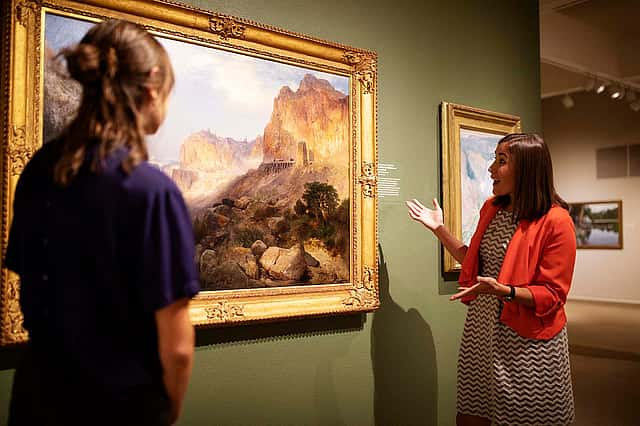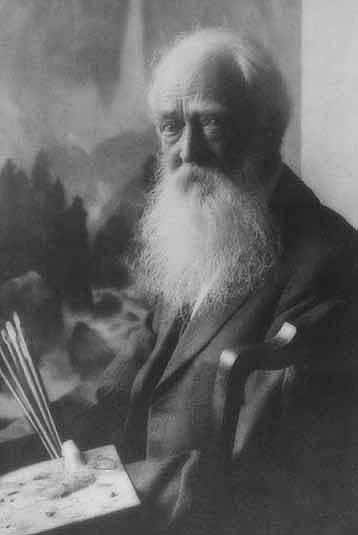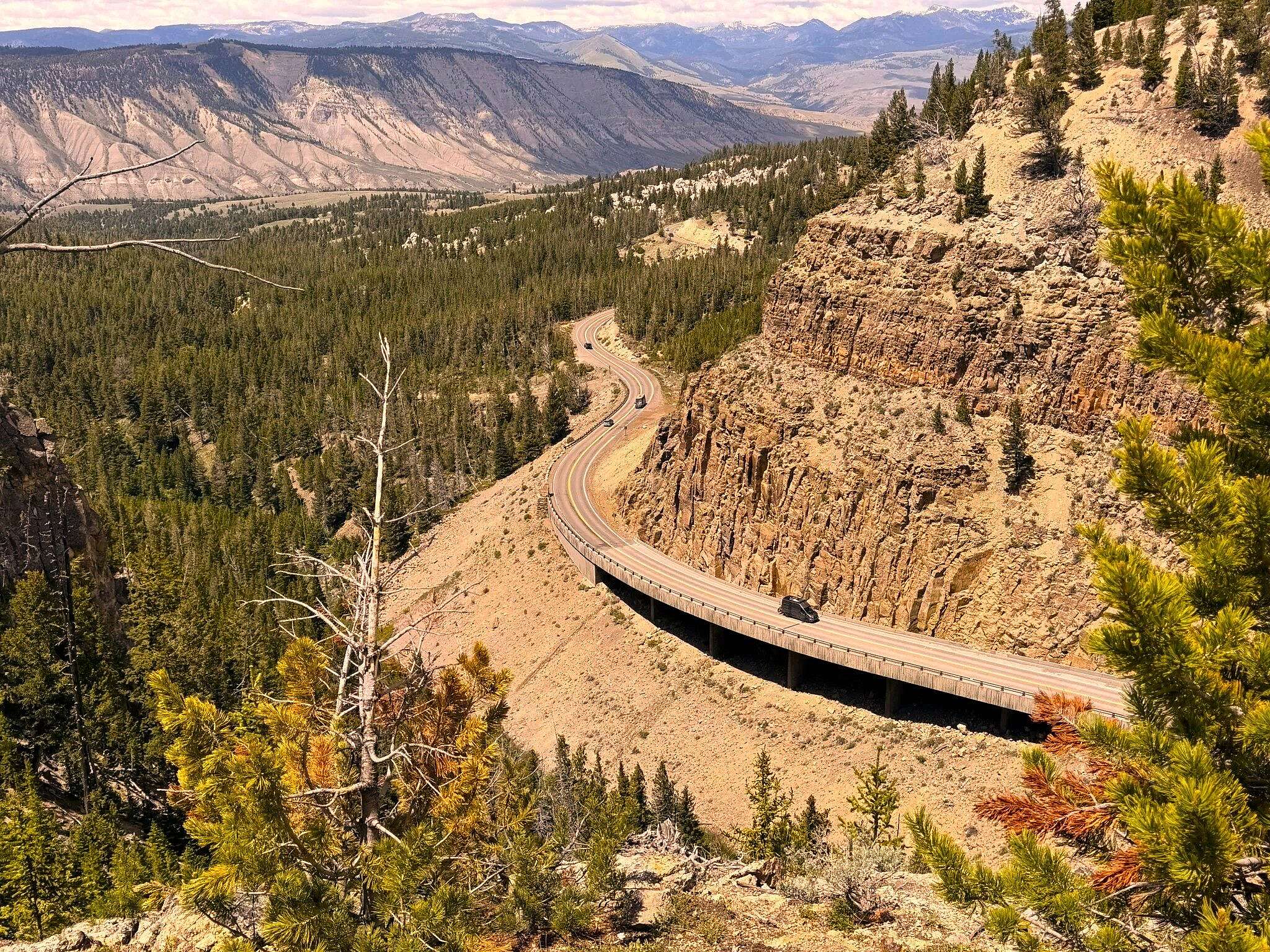
Brushstrokes of a Nation: Golden Gate, Yellowstone
One of Thomas Moran’s most iconic landscape paintings hangs in the Whitney Western Art Museum at the Buffalo Bill Center of the West. Recently, I spent a tranquil 30 minutes giving Golden Gate, Yellowstone a thorough examination, just gazing through the canvas, letting it fill my soul with inspiration and curiosity. Travelers to Yellowstone National Park can visit the very spot that Moran so beautifully depicts—about four miles south of Mammoth between Bunsen Peak and an unnamed slope that leads toward the Gallatin Range. Glen Creek carves this canyon known for its blonde rhyolite cliffs and the historic Golden Gate Pass. One of Moran’s equally talented contemporaries, Frederic Remington, wrote of Moran’s work in a January 1895 issue of Harper’s Weekly, “It is one of those marvelous vistas of mountain scenery utterly beyond the pen or brush of any man. Paint cannot touch it, and words are wasted…. I marveled at the courage of the man who dared the deed.” As an immigrant who forged his path through talent and determination, Moran helped define American culture through paintings that still inspire awe today. As we reflect upon 250 years of our nation’s history, Moran’s story as an immigrant who rose to national prominence reminds us of the individual vision and enduring creativity that helped build America.

Early Life
Born in Bolton, England in 1837, Moran and his family immigrated to America in 1844 seeking a better life and more opportunity for success. Eventually they settled in the Kensington neighborhood of Philadelphia where, as a teenager, Thomas obtained employment with a wood-engraving firm called Scattergood & Telfer. Indifferent towards wood-engraving, Moran began illustrating, sketching, and painting outside of work, honing his talents by studying influential painters like Joseph M.W. Turner. In fact, Moran returned to England in 1862 to study Turner’s use of evocative color and light and his emphasis on the emotive and spiritual aspects of painting landscapes. While they never met, Moran adopted many of Turner’s techniques and many later considered Moran Turner’s American artistic descendent.
Rise to Prominence
Around 1871, an illustrated cultural magazine called Scribner’s Monthly named Thomas Moran their chief illustrator, giving him the national platform necessary to fully promote his artwork. Working at Scriber’s boosted his career immensely, with major writers, explorers, scientists, and magnates taking notice of his work. Moran also became quite skilled in chromolithography, enabling him to share vibrant, colorful reproductions of his artwork with le petite bourgeoisie. The result: Moran brought his visions of the West into ordinary Americans’ homes, giving all a chance to see the likes of Yellowstone and the Grand Canyon—places they would never have the means to visit in person.
The Yellowstone Expedition
In 1871, railroad magnate Jay Cooke (also from Philadelphia) sponsored the U.S. Geological Survey Expedition to the Yellowstone region led by Ferdinand V. Hayden. Cooke understood how photography and art could help persuade President Grant and Congress to establish Yellowstone as the nation’s first national park. Cooke encouraged Hayden to invite Thomas Moran and photographer William H. Jackson on the expedition. Moran spent 40 days in the wilderness sketching and keeping detailed notes about the landscape. In 1872, his work, alongside that of William Jackson, helped influence President Grant to designate Yellowstone as the first National Park. His paintings of Yellowstone earned him the endearing and enduring sobriquet: Thomas “Yellowstone” Moran.
The Painting: Golden Gate, Yellowstone
Twenty years later in 1892, at the invitation of Elwood Mead—Wyoming’s first State Engineer—Moran returned to Yellowstone with William Jackson. The purpose: to gather images in preparation for the World’s Columbian Exposition in Chicago meant to commemorate the 400th anniversary of Christopher Columbus’s arrival to North America. Like Jay Cooke, Elwood Mead understood how Moran’s art could sway public opinion, so he invited him (and Jackson) to promote preservation of Wyoming’s natural wonders. With any luck, the intersection of art and engineering would work in tandem to help create viable infrastructure, while opening the landscape to visitors—giving it national standing.
In 1893 Moran painted Golden Gate, Yellowstone based upon five sketches from his 1892 trip with Mead and Jackson. The focal point of the painting—a narrow and steep canyon with deep, dusky colors occupying the foreground—contrasts the towering cliffs bathed in golden yellow sunshine; making a normally modest scene seem ethereal. Gazing upon Golden Gate is like sipping a rare vintage from the cup of perfection poured right from the artist’s brush.

Artistic Legacy and Style
In terms of style and influence, art historians place Moran in the Hudson River School of artists; not an actual school, but instead a philosophy or approach to painting. The Hudson Riverites—Bierstadt, Cole, Durand, and Moran to name a few—emphasized Romantic Era ideals, the grandeur of the American landscape, and an emphasis on American originality over established European art practices. Moran depicts the canyon’s primal allure, demonstrating the 19th century transcendental tenet of nature as a fountainhead of truth and beauty. In her book Nature and Culture: American Landscape Painting, 1825-1875 author Barbara Novak draws ties between the transcendentalist movement led by such thinkers/writers as Emerson and Thoreau to the Hudson River artists, calling the American landscape “sacred text” for both groups. Moran’s paintings reflect these principles and allude to the idea of Manifest Destiny, celebrating the American West on canvas.
Art as Inspiration
As a landmark in our national consciousness, Golden Gate, Yellowstone reminds us how art inspires awe, wonder, and a curiosity about what’s beyond the next rise, what’s around the next bend, and what’s over the horizon. Thomas Moran’s artistic journey through life reveals how passion, vision, and a respect for nature can preserve it for generations going forward. Ars gratia artis.

Written By
Jane Gilvary
Jane Gilvary is a Content Specialist in the Public Relations Department at the Center of the West. She writes and manages web content and serves as editor of the Center’s monthly e-newsletter, Western Wire. Outside of work, Jane enjoys exploring Wyoming’s backcountry and discovering its hidden treasures.
